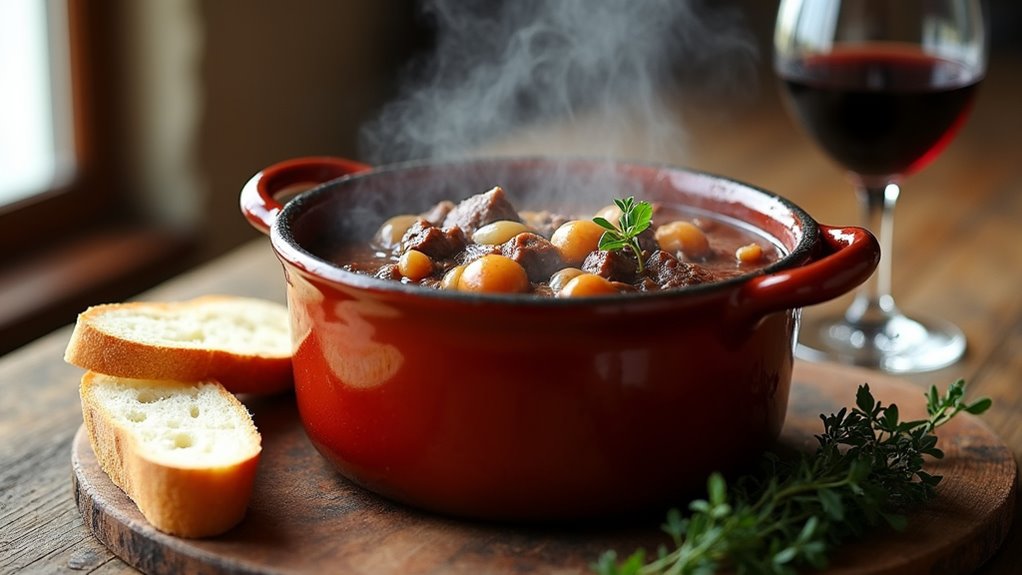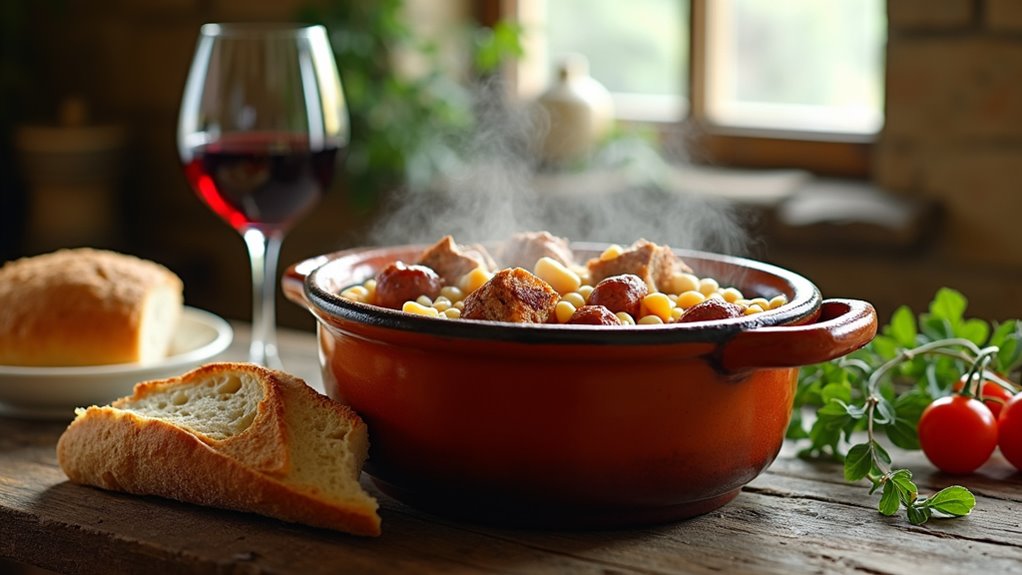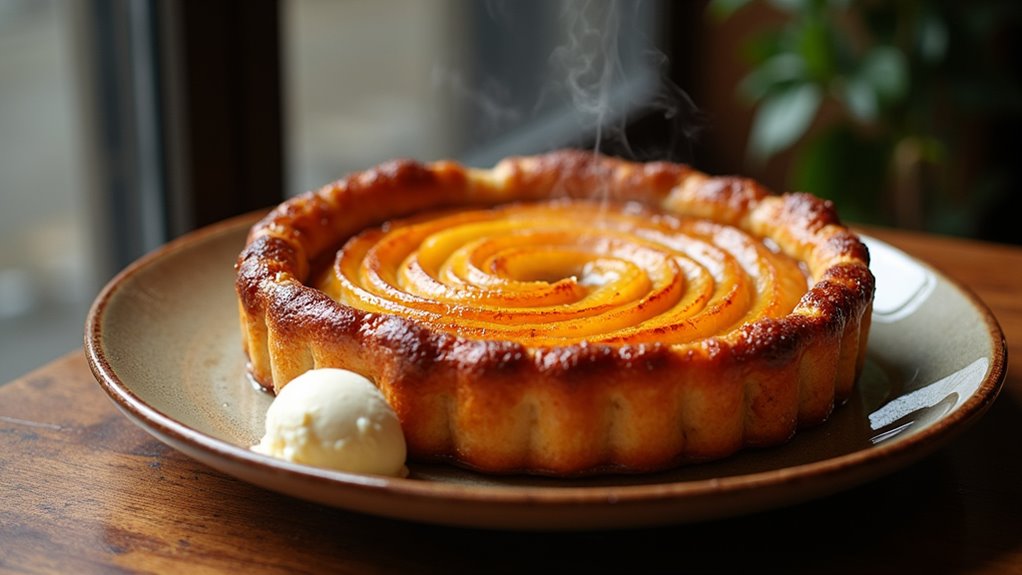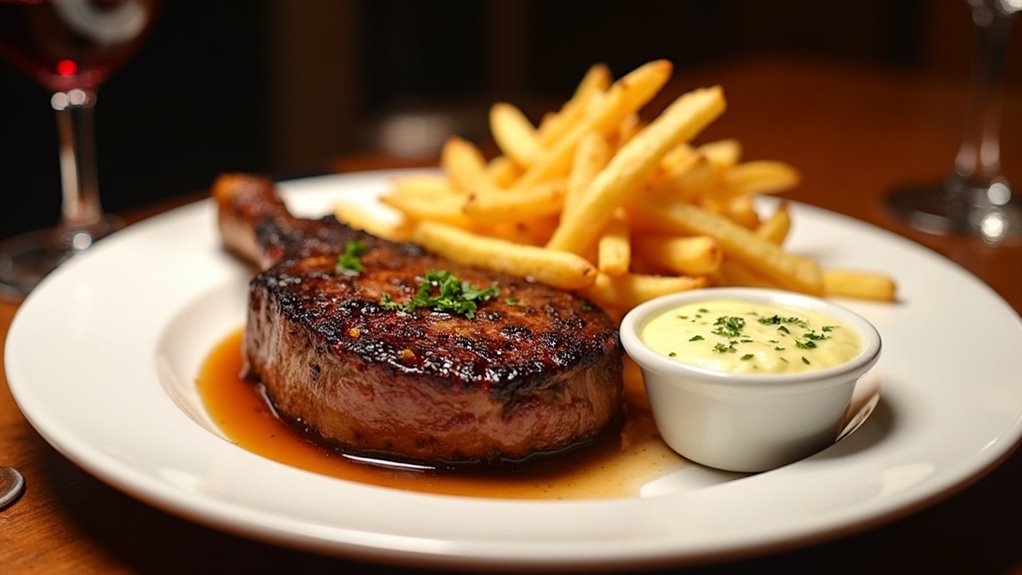Physical Address
304 North Cardinal St.
Dorchester Center, MA 02124
Physical Address
304 North Cardinal St.
Dorchester Center, MA 02124

Discover France's most beloved culinary treasures, from rustic classics to sophisticated delights that have shaped global gastronomy.
France’s culinary landscape offers nine iconic dishes you shouldn’t miss. From Burgundy’s opulent Beef Bourguignon to Marseille’s aromatic Bouillabaisse, each region boasts distinctive flavors. Try the accidental dessert Tarte Tatin, colorful Ratatouille from Provence, or the bistro classic Steak-Frites. Don’t overlook daily rituals like buttery Croissants or regional Cheeses, and taste the tender Coq au Vin and hearty Cassoulet. These dishes reveal the soul of French food culture beyond their delicious exteriors.

What could better embody French culinary heritage than a pot of beef bourguignon simmering on the stove? This iconic dish originated in Burgundy, where cattle farming and wine production have thrived for centuries.
You’ll taste the essence of French cooking technique as tender chunks of beef shoulder melt after hours of slow cooking in opulent Pinot Noir. The dish requires cuts with white fat streaks visible throughout, ensuring the meat becomes perfectly tender. The magic happens when garlic, thyme, bay leaves, and smoky lardons merge with the wine-infused sauce, traditionally thickened with beurre manié.
While modern adaptations might use pressure cookers or substitute ingredients for dietary needs, traditionalists insist on the authentic three-hour method. Similar to exploring Zagreb’s culinary scene, discovering authentic beef bourguignon offers a window into local culture and tradition.
When in France, you’ll find this comforting stew served in bistros throughout winter, always paired with the same wine used in cooking.
How could a humble bird swimming in wine become one of France’s most beloved culinary treasures? This dish, literally “rooster in wine,” began as a practical solution for tenderizing tough roosters in rural France before transforming into haute cuisine.
You’ll find chicken (typically thighs and drumsticks) braised in Burgundy Pinot Noir until fork-tender, accompanied by a symphony of bacon, mushrooms, and pearl onions. Much like traditional Polish cuisine, this classic French dish celebrates the art of slow cooking with rich, complex flavors. The magic happens during marination and slow cooking, when the meat absorbs the wine’s complex flavors. For authentic results, the chicken should be marinated overnight in wine with aromatic herbs to develop deep flavor profiles.
While Julia Child helped popularize coq au vin internationally in 1961, it remains quintessentially French—embodying the cuisine bourgeoise tradition of elevated home cooking. Today’s versions might use white wine or incorporate modern equipment, but the soul of this comforting dish remains unchanged.

When winter winds whistle through the valleys of Southwest France, locals turn to their most cherished comfort food: cassoulet. This iconic peasant dish originated in towns like Toulouse, Castelnaudary, and Carcassonne, taking its name from the traditional earthenware “cassole” it’s baked in.
You’ll find large white beans slowly simmered with various meats—duck confit, pork sausage, and ribs—alongside aromatics like garlic and herbs. What makes cassoulet special is its signature crust, broken and reformed multiple times during its 2-3 hour bake.
Each region fiercely defends its version: Toulousain includes duck confit while Castelnaudary stays pork-focused. Julia Child once described this rustic delicacy as both ambrosia for gastronomes and everyday fare.
For the most authentic experience, enjoy it with crusty bread and local red wine after it’s rested for a day, allowing the flavors to intensify beautifully. Some of France’s luxury holiday destinations feature restaurants where cassoulet is elevated to gourmet status while still honoring its humble origins.
Why does Marseille’s most famous dish inspire such fierce devotion among culinary purists? Because authentic bouillabaisse isn’t just food—it’s history in a bowl.
Born from fishermen using unsold catch, this humble stew now has its own charter protecting its integrity.
From fishermen’s leftovers to protected cultural treasure—bouillabaisse transformed humble origins into culinary heritage.
You’ll recognize real bouillabaisse by its saffron-infused broth containing at least four Mediterranean fish varieties. The broth requires a specific cooking technique where it is vigorously boiled before being gently simmered to develop its complex flavors. The theater of presentation matters too—broth served separately from the fish, accompanied by rouille (a garlicky saffron mayo) and crusty bread.
Don’t be fooled by imitations! Traditional preparation demands fish bones for a sumptuous stock before delicately poaching the fillets.
What began as working-class sustenance has evolved into Provence’s culinary crown jewel, celebrated annually at Marseille’s Fête de la Bouillabaisse.

From the Mediterranean’s most celebrated fish soup, we now travel inland to discover France’s most beloved “mistake.” The story of Tarte Tatin reads like culinary folklore—a dessert born from kitchen chaos in the late 1800s at a modest hotel in Lamotte-Beuvron.
As legend has it, Stephanie Tatin accidentally placed pastry atop cooking apples, creating what would become an iconic upside-down dessert. The magic happens when apples caramelize in butter and sugar before being topped with pâte brisée and baked. The success of this dessert relies on selecting hard and tart apples that perfectly balance the caramel’s sweetness.
When flipped, you’ll discover perfectly caramelized fruit atop crisp pastry.
You’ll find this dessert everywhere from Parisian bistros to high-end establishments like Maxim’s. For the authentic experience, enjoy your slice warm with a dollop of crème fraîche. This French culinary icon showcases the country’s talent for transforming simple ingredients into extraordinary dishes worth savoring.
The vibrant countryside of Provence gave birth to one of France’s most colorful and celebrated vegetable dishes—ratatouille. This rustic 18th-century creation showcases summer’s bounty, combining eggplant, zucchini, tomatoes, and bell peppers into a delicious medley.
You’ll find ratatouille prepared in various ways throughout France. Traditionally, each vegetable is cooked separately before being slowly simmered together with aromatic herbs. For authentic flavor development, dried herbs are rubbed between fingers before adding to awaken their essential oils and aromatics.
The Disney film popularized the elegant “confit byaldi” variation with its spiral-arranged vegetables.
Whether served hot as a main dish or cold as a side, ratatouille pairs beautifully with crusty baguettes or grilled proteins. Try it with a glass of Provençal rosé for an authentic experience.
Don’t hesitate to use leftovers in omelets or pasta dishes—ratatouille’s flavors often improve overnight! Many travelers find that enjoying this dish brings the same colorful experience as snorkeling in Dubrovnik with its vibrant underwater sights.

While originating in Austria, croissants have been embraced and perfected by the French, becoming an essential part of their morning ritual alongside their chocolate-filled cousin, pain au chocolat. You’ll find these buttery, flaky pastries in virtually every bakery across France.
The magic lies in the lamination process—layers of butter folded between dough create that distinctive airy texture when baked. Locals typically enjoy these treats with coffee, often standing at café counters or during leisurely family breakfasts. Many couples visiting France seek out these authentic culinary experiences, much like those exploring the Adriatic coastline for romantic getaways.
For an authentic experience, seek out bakeries using traditional methods. The pain au chocolat is crafted by filling rectangles of dough with chocolat batons and rolling them into scroll shapes. You’ll know you’ve found quality when the pastry shatters delicately with each bite, revealing a honeycomb of buttery layers inside. They’re more than food—they’re daily cultural touchstones.
French cheese appreciation represents perhaps the most quintessential aspect of the country’s gastronomic heritage, with over 1,500 distinct varieties crafted across diverse regions. You’ll discover a world where texture, aroma, and flavor create unforgettable tasting experiences. While deciding on your European vacation, you might consider Mediterranean destinations like Greece or Italy, but France offers unparalleled culinary experiences.
When exploring French cheese, remember these essentials:

Steeped in abundant culinary tradition, steak-frites remains perhaps France’s most beloved bistro offering, combining buttery seared steak with perfectly crisp double-fried potatoes.
You’ll find this 19th-century Parisian creation on nearly every brasserie menu, from neighborhood cafés to upscale establishments. The magic lies in its deceptive simplicity—ribeye or filet mignon seared in cast iron, continuously basted with herb-infused butter, then rested while potatoes undergo their signature double-fry technique. Many chefs employ the cold-start frying method, where potatoes are placed in room temperature oil and cooked for about 25 minutes until achieving that golden crispy exterior.
The result? Caramelized meat paired with frites that are fluffy inside yet crisp outside.
Don’t miss the accompanying sauces—béarnaise, peppercorn, or secret house recipes—that elevate this dish. This quintessential meal is particularly affordable in budget-friendly regions like Montpellier and Toulouse. Pair it with a robust Bordeaux for the quintessential French dining experience that has seduced locals and visitors alike for generations.
From savory Beef Bourguignon to buttery croissants, you’ve now glimpsed the heart and soul of French cuisine. These nine dishes are just the tip of the culinary iceberg that makes France a food lover’s paradise. Whether you’re planning a trip or cooking at home, don’t hesitate to learn about these authentic flavors. After all, experiencing French food culture isn’t just eating—it’s celebrating centuries of delicious tradition!